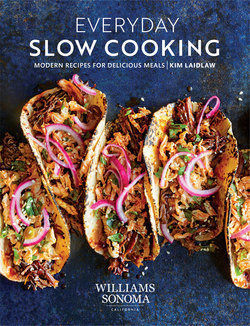Читать книгу Everyday Slow Cooking - Kim Laidlaw - Страница 12
На сайте Литреса книга снята с продажи.
Оглавление11
Slow cookers come in various shapes and sizes. The recipes in this book were designed for and tested in an oval 6-qt (6-l) slow cooker with dual temperature settings, a ceramic cooking insert, and a tempered gass lid. The lid makes it easy to check on food without lifting it and releasing the built-up heat. Any browning steps were done in a frying or other pan on the stove top. Most of the recipes in this book yield six to eight servings, which means you can make dinner for tonight and, depending on your family size, have enough left over for another full meal (see page 8 for storage tips). Before using your slow cooker, read through its instruction booklet carefully. It will detail the product’s features, information that will help you get the most out of the appliance.
Stove Top-Safe Inserts
Some slow cooker models feature a cast-aluminum insert that can be used on gas and electric stove tops. If you have one of these, you can do the initial browning in the insert, rather than in a frying pan as called for in the recipes. In most cases, you will need to brown the item in batches to avoid crowding. Be sure to check the manufacturer’s directions before using your insert on the stove top. Most ceramic inserts cannot be used on the stove top.
Small Slow Cookers
In general, the recipes in this book will also work well in a 5-qt (4.7-l) or a 7-qt (6.6-l) slow cooker. If you are using a smaller slow cooker—3 ½ to 4 qt (3.3 to 3.8 l)—you will need to cut the recipe by one-third or one-half. Never fill the insert more than three-fourths full. The cooking time will remain the same.
Heat Settings
When making any recipe, follow the directions for temperature setting and for timing, as they are the keys to safe and successful slow cooking. Some recipes offer both a low-heat option and a high-heat option to make it easier to fit them into your schedule. The high setting is practical when you would like to speed up the slow-cooking process—often to about half the time of the low setting. I prefer to cook most recipes on the low setting, however, as it delivers fuller favors and renders tough
cuts of meat more tender, plus today’s slow cookers tend to cook at higher temperatures than older slow cookers. The high setting can cause the liquid to simmer rapidly, rather than slowly, and can lead to tougher protein, too much condensation, and disappointing results. If you do want to convert the low setting to the high setting, cut the time in half, check the results, then continue to cook for another hour if needed.
Different brands of slow cooker cook at slightly different temperatures, so you may need to adjust recipes accordingly once you get to know your slow cooker. If you are preparing the recipes in this book using an older model, you may find you must add to the overall cooking time, as it will likely cook at a slightly lower temperature.
Many models also have a warm setting that holds food at the ideal serving temperature, automatically switching to it when the cooking is done. Be sure never to cook at this setting.
ADAPTINGRECIPES FOR ASLOW COOKER
The beauty of a slow cooker is that you can throw everything into it, set the timer, and leave the house, unlike conventional recipes that require tending as they cook on the stove top or in the oven. But your favorite stews, soups, and braised meats can be successfully adapted to a slow cooker by following a few simple steps.
• Choose a recipe that is slowly simmered, braised, or roasted.
• Tougher or fattier cuts, such as chuck roast, short ribs, brisket, pork shoulder, lamb shoulder, lamb shanks, leg of lamb, or dark-meat poultry, work best in a slow cooker.
• Select a recipe that is appropriate for the size of your slow cooker. For example, a recipe for chili that serves four can be doubled for a 6-qt (5.7-l) slow cooker.
• Reduce the amount of liquid by about half, as there is less evaporation when using a slow cooker. If the recipe doesn’t call for liquid, add at least ½ cup (120 ml) broth or other liquid.
• If you have too much thin liquid at the end of cooking, pour it into a saucepan and simmer over medium-high heat until reduced and slightly thickened.
GETTING THE MOST OUT OF YOURSLOWCOOKER
